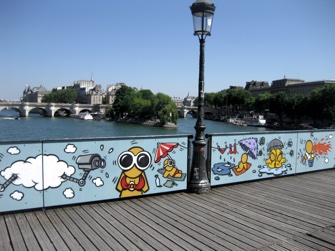
Try this: on any busy city street, stop passers-by at random and ask them, “Where is the world capital of love?” If you are a woman, most of the guys will say, “Under the blue light in my bedroom, baby!” If you are a guy, most of the women will say, “I’m calling the police.” Everyone else will say “Paris.”
But now it looks as though the City of Light might be losing its heavyweight title in the City of Love division. Don’t get me wrong: it’s still a seductively beautiful town full of charming tree-lined streets, romantic candle-lit bistros and hotels with special afternoon rates.
None of that has changed. But a new development is generating dismay and even outrage among the world’s amorously inclined population: the “love locks” have been removed from the Pont des Arts.
If you’ve never heard of love locks, you obviously haven’t been living under a bridge in Paris. As I explained in one of my very first C’est Ironique articles, it has become a “thing” in recent years for couples to inscribe their names on a padlock, attach it to the Pont des Arts (or one of the other bridges over the Seine) and throw the key into the water, leaving the lock as a symbol of their undying love.
Also of their self-absorption, disregard for public property and susceptibility to ill-conceived crazes. But mostly their undying love.
The origins of the trend are only slightly less obscure than the origins of the universe, life on Earth and the poodle-in-the-microwave story. Apparently the idea of love locks dates back to a Serbian legend from World War I and was popularized by an Italian movie that came out in 2007. And whose producer wishes he had licensed the concept.
What is certain is that, in about 2008, padlocks with names and initials on them started appearing on bridges all over the world.
At some point around then, two nameless but ahead-of-the-curve lovers were walking across the Pont des Arts and, noticing that it was a lovely footbridge over a comely river offering a breathtaking view of a stunning city — and, most importantly, that it had wire mesh side panels — one of them said, “I’ve got a great idea! Let’s buy a padlock, put our names on it and fix it permanently to this railing so that we can show everyone in the world how oblivious we are to the preservation of historical monuments, and, with any luck, spark a fad that will eventually trash the whole friggin’ bridge! Bwahahahaha!!!” Or words to that effect.
Of course we don’t know who it was. It’s one of those things, like saying “No way, José,” wearing a baseball cap backwards or putting a tennis ball on a trailer hitch — obviously someone was the first to do it, but determining who is essentially impossible.
On the other hand, I imagine that there are many couples who would be glad to claim the distinction, rather like the 11 men who all claimed to be the sailor kissing the nurse in Alfred Eisenstaedt’s famous photograph of Times Square on V-J Day 1945. (Personally I suspect that 10 of them knew perfectly well that it wasn’t them but were hoping to get invited to re-enactments.)
In any case, somebody did it. And then somebody else did it. And then, noticing that somebody else had done it, somebody else did it. And so on. And so on. And so on. And so on. And — stop me if you’ve heard this one before — so on.
Eventually the bridge was literally heaped with padlocks from end to end. And then, as the Pont des Arts filled up, the locks spread, fungus-like, along the moist, humid, low-lying bits of the Parisian cityscape.
They started cropping up all along the Seine, first on the Passerelle Léopold-Sédar-Senghor by the Musée d’Orsay, then the Pont de l’Archevêché behind Notre Dame, the little bridges across the Canal Saint Martin, and even the chain around the replica of the Statue of Liberty flame at Pont d’Alma:
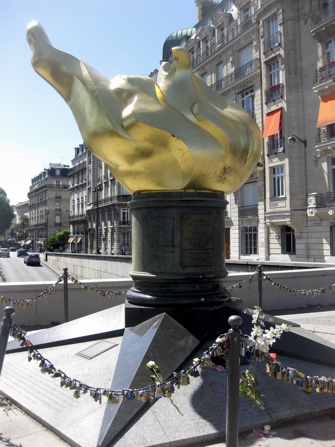
Installed in 1989, the “Flamme de la Liberté” had already become a de facto memorial to Princess Diana (hence the flowers) because it happens to be near the tunnel where she met her horrifically tragic end and, apparently, because it sort of resembles a “Candle in the Wind.” Speaking of appropriating public monuments for private purposes. But that’s a different story.
Time went on, and the love locks on the Pont des Arts became a textbook example of a psychological mechanism familiar to anyone who has ever polished off an entire economy-size bag of tortilla chips in a single sitting: the “just one more” principle.
We all know how it works: one more cigarette won’t kill you, one more gas-guzzling SUV won’t wreck the environment, one more shovelful of manure won’t overfill this five-pound bag, etc.
In 2012 I wrote an update warning that, in the case of love locks, there wasn’t really room for one more. Already back then, it looked to me as though the Pont des Arts was filled to capacity:
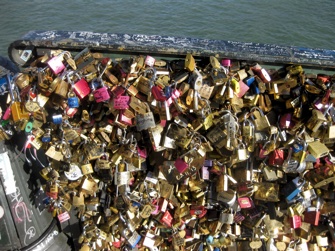
Little did I know! The padlock ritual was mentioned in guidebooks and soon became a “must-do” for tourists. Lovestruck visitors to Paris continued to put locks on the existing locks, and then locks on the locks on the locks, etc., until the bridge’s side barriers were no longer even visible, buried under an ever-growing mass of security-grade metal.
The public works people warned that the extra weight posed a danger to the Pont des Arts, which, as a pedestrian bridge, wasn’t built to withstand tremendous loads. And by Gaullie they were right: a lock-laden chunk of the railing broke loose in 2014, constituting a slight but genuine threat to public safety.
Finally, earlier this year the sides of the bridge were covered with boards to prevent any further damage. And the boards in turn were instantaneously covered with graffiti, completing the transformation of Paris’s most romantic bridge into its most appalling eyesore, and reminding everyone that Paris has its own local narcissistic vandals as well:
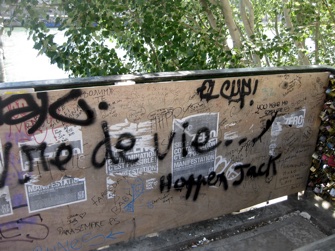
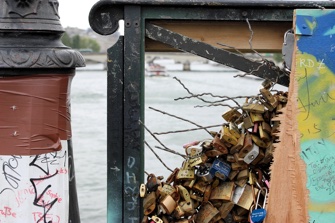
One tourist was quoted in the press as saying, “It’s stupid and a pity.” These are my feelings exactly, except that he was referring to the removal, not the presence, of the padlocks.
And still the locks kept coming. Lovebirds went airborne to put them on the bridge’s lamp posts:
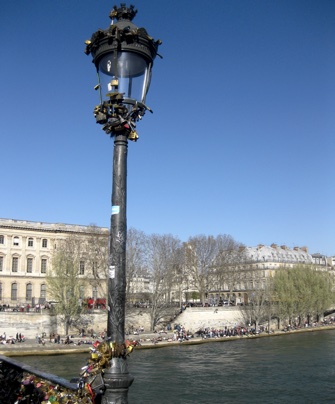
And claimed the fence around the square in the middle of the next bridge, Pont Neuf, as property of the Sovereign Kingdom of Amour:
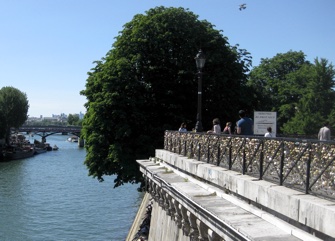
Even then, City Hall refused to ban the locks out of concern that it might tarnish Paris’s love-friendly image. But finally, this year, enough was assez, and on June 1 the wire panels, each crammed with thousands of locks, were removed from the Pont des Arts.
By that time, according to a deputy mayor, the bridge was encumbered with about 700,000 padlocks weighing 45 metric tons, which most news sources equated to the combined strain of 20 elephants. Living up to the principle of “it takes a thief,” I detect an exaggeration here.
Basing my calculation on the average of 11,000 pounds for an adult Asian elephant, as mentioned in the FAQ section of a website devoted to the big lunks, I get a PDA (PachyDermatous Analogy) rating of nine on the nose. I mean trunk.
But whatever their net weight, or sentimental worth, the locks were carted away, taking a huge burden off of both the bridge’s understructure and the minds of all the French-bashing foreign journalists who were wondering what to write about next.
The Francophobes had a field day with the story, spinning it as a declaration of “war on love” by the wet-blanket-and-satin-sheets Parisian administration. One particularly snide article in a British newspaper, which I won’t identify here except to say that in Opposite World it would be called The Nightly Femail, tried hard to imply that the city took off the locks solely due to pressure by puritanical, killjoy locals.
Imagine! Pandering to the sensible complaints of their constituents instead of the destructive whims of one-time short-term visitors! The nerve!
Twice, the report describes the city crew as “unceremoniously” removing the symbols of thousands of poignant love stories. But seriously: they’re a work team with hard hats, bolt cutters, cranes and a schedule — what exactly were they supposed to do in the way of “ceremony”? Strew their tarps with rose petals? Release doves? Observe 700,000 minutes of silence?
I was surprised how many media sources took a similar stance, vilifying Paris for this dastardly attack on mankind’s noblest emotion. Many reported that the locks were shorn because the city authorities “feared” that the bridge might collapse, making it sound more like a neurosis than an engineering calculation.
“Fear” is not the right word here. The Pont des Arts was gaining some 50 pounds of padlocks every single day — the city authorities were absolutely certain that it would eventually collapse. What they “feared” was that it might happen when there weren’t any sensationalist reporters under it.
The attitude among the journalists, and the disappointed foreign tourists they talked to, seemed to be: “If Paris is really the City of Love, then they should have built the bridge, which was designed in 1802, to hold 3.5 billion padlocks, since that equals the number of possible couples in the world today. Oh wait — more, because, you know, people break up, and then they have to come back and put on another unremovable lock for their next everlasting relationship. A bigger one.”
Sadly for sweethearts on vacation and a hormone high, this will no longer be possible, at least on the main span of the Pont des Arts. The barriers are now lined with temporary panels decorated, or “decorated” depending on your taste in paintings, by street artists, and by the end of the year they will be replaced with new permanent panels — clear, graffiti-resistant and, most importantly, with no gaps or holes where anyone can slip in a dieudamned padlock.
Well, that’s all I have to say about love locks, but before I end this article I just want to mention: I saw a great Italian movie the other day — sure to be a huge hit. It’s about a couple of lovers from Serbia who travel around Europe, carrying a small battery-powered electric drill with them everywhere they go…
For a clear, level-headed explanation of the love locks phenomenon, with actual rational thoughts, I recommend this blog post by Bryan Pirolli, who also contributed a photo for this article.
Reader Ron Fox writes: “I find it hard to determine who is less intelligent (stupider): those who attach the locks or those who take photos of them. Please note that the idiocy continues on the approaches to the Pont des Arts. Pont de l’Archevêque and elsewhere. Phillistines.”
Reader Margo Berdeshevsky writes: “Have said it before, saying it again. Yay! Get rid of the chastity belts! ‘Locks’ ain’t love; they are symbols of prisons. Sooo happy they will be history. Bye-bye f-in locks. One more dumb idea bites the dust, or the hands that fed it. Misanthrope? Not at all. Just someone who loves Paris and NOT what messes with its scenery. Grrrr. and YAY!”
© 2015 Paris Update
FavoriteAn album of David Jaggard’s comic compositions is now available for streaming on Spotify and Apple Music, for purchase (whole or track by track) on iTunes and Amazon, and on every other music downloading service in the known universe, under the title “Totally Unrelated.”
Note to readers: David Jaggard’s e-book Quorum of One: Satire 1998-2011 is available from Amazon as well as iTunes, iBookstore, Nook, Reader Store, Kobo, Copia and many other distributors.
